Investor:The Stories Behind Popular Blockchain Games such as Catizen and Matr1x
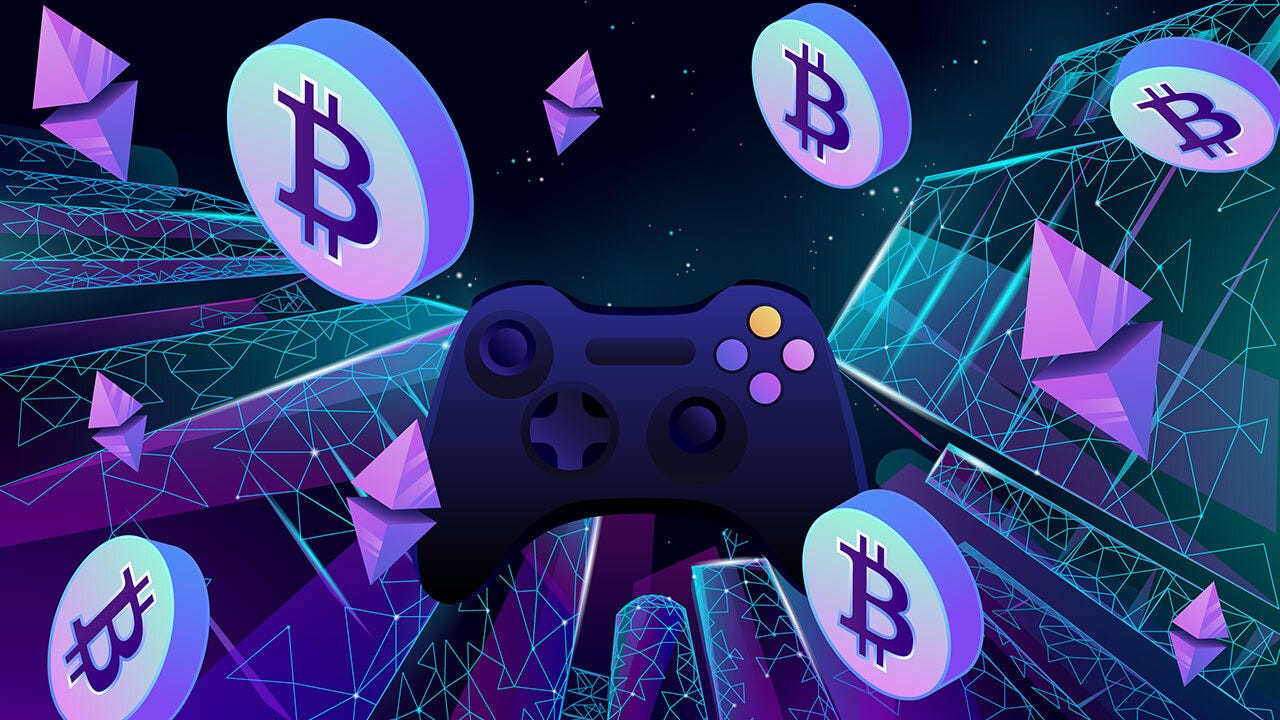
Author: Chain Tea House
Translation: WuBlockchain
As several popular Web3 Game projects have been listed on major exchanges such as Binance, OKX, and Bybit, the wealth effect has begun to show. Many community users who have grown alongside these games are celebrating early. The Web3 gaming track is heating up. However, besides the well-known Axie from the last cycle, what paradigm shifts, innovations, and changes in the new infrastructure environment are emerging in the new cycle's games? These are questions that both the industry and investors need to ponder.
Chain Tea House has specially invited Initiate Capital, the investor behind popular games this cycle such as Matr1x FIRE and Catizen.
In this exclusive interview with Chain Tea House, we spoke with Chen Yuetian, a partner at Initiate Capital. As an investor, he shared unique insights into the crypto market and future development trends. He also introduced Initiate Capital's strategies for supporting Web3 game development teams, citing successful projects invested in by Initiate. Additionally, they revealed how to evaluate and select potential investment projects in a complex market environment.
Join us as we explore the future path of Web3 games.
1. Please briefly introduce yourself and Initiate Capital.
Our company, Initiate Capital, was founded in 2021. I have over ten years of experience in equity investment, mainly focusing on youth culture and entertainment, particularly in China's ACG (anime, comics, games) sector. The goal of founding Initiate Capital was to continue my previous investments. Although equity investments in China's media sector have faced challenges in recent years, I still believe that investing in the cultural and entertainment sectors is worthwhile and should be supported.
The primary goal of Initiate Capital is to continue investing in content production and consumption, as well as business models in the youth culture field. Our investment tools have gradually expanded from equity investment to cooperation with listed companies and secondary market stock investments. With the rise of crypto as a new capital tool, we have also actively adopted it.
Initiate Capital currently focuses on the crypto sector, particularly on investments in crypto games. Since its inception in January 2023, the fund has invested in over twenty projects. For example, the popular game Catizen in the TON ecosystem and the Southeast Asian shooting game Matr1x Fire. We have also invested in developing projects like Space Nation, Arena of Faith, and AI+Web3 application layer project MyShell.ai.
Since the fund was established during the bear market, we focused on early-stage projects and have seen excellent performance from these teams in terms of user numbers, activity, revenue, and exploration of business models. Although the industry has experienced boom and bust cycles, we are confident about the future and are willing to share our insights to help rebuild confidence.
2. Since you've mentioned several cases, could you share a story about one of your investments? What was the process from encountering the project to making the final decision like?
The experiences of the five or six projects I just mentioned vary, but each is representative in its own field.
Take Catizen, for example. Their team had previously developed a blockchain game in the last cycle. The innovation at that time was to find a way to bring the game to mobile devices and simplify its controls. So they ended up creating a very simple mobile-based, browser-like experience. They then integrated a token as the in-game currency. Although the innovation was limited at that time, the market in 2021 felt that this was enough. The token performed well, and investors made money.
At that time, I had not yet encountered this team. Later, in 2022, when I decided to delve deeper into crypto games, I met this team through mutual friends. We discussed the innovations of their new project, and they mentioned that they wanted to create a lighter, more casual game. Not targeted at the mainstream male Web3 audience. As we know, in traditional Web2 games, female users account for a significant portion of the casual game market. I thought this was a good idea, but the main issue with casual games is how to spread them, especially since there was no ecosystem development in Telegram at the time. A serious game development team understood strategically that casual games are more social, and needed to find a foundational social network. It just so happened that Telegram was launching its Mini APP, which perfectly matched Catizen's need for a social infrastructure to better spread their game. Telegram, which had never developed an application ecosystem or monetization before, matched well with Catizen's needs.

Catizen was initially called Cat Paradise. The game didn't change much, but it quickly found a platform for traffic acquisition. The method of acquiring users was particularly effective on Telegram. In the past, social games needed a pre-existing social network. For example, in Telegram, there are many groups. If you spread it on WeChat, each group might have 200 to 500 people, while in Telegram, groups can have thousands or even tens of thousands of people. Thus, acquiring users became much easier.
This is the story of Catizen. For a team like Matr1x FIRE, I followed them for a long time. The reason I kept in touch with this team was that one of the members was particularly knowledgeable about how to capitalize on crypto and utilize it effectively. This individual, who was very familiar with the crypto market, had been known to me for many years from our equity investment days. He was earlier and more deeply involved in the crypto industry than I was.
He told me about his collaboration with a team that had previously worked on a game similar to CS: GO. After talking with the team and cross-referencing my own Web2 industry resources, I confirmed that they had the relevant background. Seeing their determination to develop a Web3 game in early 2022, combined with prior development experience and a team member who understood crypto deeply, they were ready to innovate in both product and business models.
I was eager to support such a team. This aligns with my strategy of finding a group of highly capable Web2 game developers in China. The Web2 game market is terrible, with commercial releases needing a license. Only 1,000 licenses are issued per year, and we predicted two years ago that 1,000 would never be enough. This means that small and medium-sized developers in China have no chance of survival, leaving only the big companies. Consequently, innovation in product and business models in China's gaming industry would come to a halt.
So, we believe the limit of 1,000 licenses is a problem. Nevertheless, I still hope that China's gaming industry can continue to innovate in terms of both products and business models. Therefore, we need to support small and medium-sized teams. These teams cannot rely on traditional equity and stock market capitalization. We found that we could use crypto to support them, so that's what we did. In this sense, Matr1x perfectly fits this path as an excellent Web2 game production team combined with expertise in crypto strategies.
Last year, we had an extensive list of over 160 previously funded game developers, and Arena of Faith was on this list. At the end of 2022, the market was terrible, and they were doing some outsourcing work. We got to know them while they were helping another Web3 game with outsourcing. Later, I visited their team and found that they had excellent 2D top-down action game products. I asked them frankly, "With such good development skills, why not switch directly to Web3?" The team was hesitant at the time. By early 2023, the survival environment for small and medium-sized teams in the gaming industry had deteriorated further. We reached out to them again; they were strong in development, and Tencent had invested in them. After our interaction, we had a good conversation, and they were willing to make the switch. They had done a lot of thinking about it. However, just thinking and expressing determination is not enough; we needed to observe whether they were really transitioning to Web3 and learning new things every day.
After two months of observation in early 2023, we saw that the team's learning curve was very steep. We decided to invest because their Web2 game development capabilities had already been proven through their previous product. The key was whether they had the determination and willingness to learn new things and adapt quickly to Web3. We found that they met these criteria, so we invested. So, each team may have different paths, but they are all quite typical in their respective fields.
3. So, you've likely developed a specific investment methodology at Initiate Capital. Among the teams you've worked with, which ones met your criteria and ultimately received your investment?
Arena of Faith is a typical example among the cases we've discussed. We used that extensive list to identify potential investments and found that some companies transitioned earlier and more successfully than others. I can't mention specific names, but there have been more successful ones. They launched earlier this year, reaching a peak FDV of several billion USD, currently maintaining a valuation in the range of five to six hundred million USD.
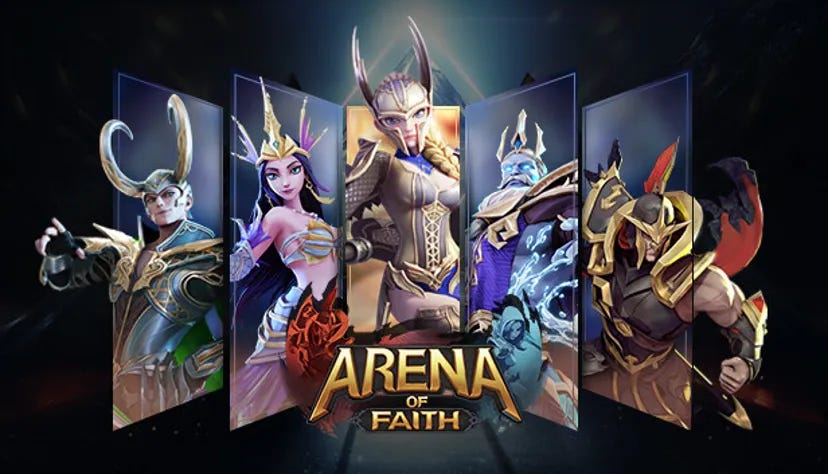
The core of that list consisted of teams that received investment from major and medium-sized companies in China during 2020 and 2021. Those years saw an intense competition in China's game investment market, with ByteDance trying to enter the game market and challenge Tencent's dominance. Both companies invested aggressively. Ultimately, Tencent couldn't stop ByteDance from acquiring Moonton for billions of USD, which led to the emergence of many excellent teams.
The reason we focused on that list is that the main issue with the Web3 game logic not working is the lack of genuinely outstanding teams and productive capacity entering the field to create fun and innovative games. This type of product innovation relies on talented individuals.
We sought out top-notch game production teams from that list. We talked to each team about the industry's challenges, future trends, and the benefits of crypto. The key was whether they were willing to embrace Web3 from the heart, not just for financial speculation, but as the future of the gaming industry. Only then could innovation happen, whether in product or business models.
The reality is that Web3 and traditional Web2 fields are quite divided. There's a significant gap between the crypto world and traditional equity-financed companies. Only a team with determination and willingness to embrace this new world can bridge this gap. Otherwise, the cognitive divide remains insurmountable.
In summary, we first selected these teams, spoke with them about the industry's future, highlighted the problems, and explained how crypto could provide solutions. We assessed whether they accepted these ideas, observed their progress, and followed up with them regularly. If they were truly on board, they often came back to us with updated insights, and we could see their genuine commitment and growth.
For the teams that showed potential, we discussed tokenomics, market strategies, and user acquisition. As investors, our role is limited to providing guidance and support, not taking over the day-to-day tasks of a Web3 startup. We offer a general direction, follow up monthly, and, at the right time, invest funds. We check in regularly on product progress and offer support, such as connections and resources.
4. While participating in Web3 games, we have noticed some issues worth paying attention to. The current trend seems somewhat polarized: some games excel in design and experience, but the value of their assets or tokens drops sharply, causing negative feedback from players and creating a vicious cycle. On the other hand, some games have relatively ordinary designs, but their assets are highly hyped, leading players to believe that these projects have great potential. In this context, what qualities and standards do you think an ideal Web3 game should have?
There are two lines of thought in the industry.
One is that both Web2 and Web3 aspects should be strong. This means achieving the quality and gameplay innovation of Web2 games while incorporating Web3 elements. If we consider Web2 games to represent a perfect score of 100 in the gaming industry, the teams we invest in should aim for 120 or even 150, with the additional points coming from Web3 Features.
The other perspective is that the quality of the game doesn't need to be top-notch; it can be around 70-80 points, with the remaining 20 points being supplemented by Web3 elements.
Ultimately, I believe the game must have a viable business model.
Whether it's a Web2 game, a hybrid of Web2 and Web3, or a purely Web3 game, what does it mean to have a viable business model?
Since it's a software product for public use, it must generate positive cash flow. Whether it's through the sale of NFT assets, taxation, or external user transactions, the business model must work.
Moreover, the realization of a business model hinges on the number of users. A low user base is a core issue the industry currently faces. If the game primarily targets Web3 users, the user base is limited. Additionally, many Web3 users primarily engage in gold farming, so no matter how good the game is, it won't matter much. The next step must be to attract users from the traditional gaming sector, and this goal needs to be clear. Even if you make a simple game, having an effective user acquisition method is crucial. For instance, the TON ecosystem boasts 900 million monthly active users; if you can tap into that user base, you can attract users. In the WeChat mini-game ecosystem, the quality of games isn't a primary concern because there are plenty of users. You can run ads and bring in users, making the business model viable for mini-games.
Thus, there's no need to demand Web3 games reach the quality of Genshin Impact. The key is user acquisition—effectively bringing in users and ensuring they are willing to pay, thereby generating positive external cash flow, not just relying on pure speculation.
If you can't bring in new users and rely solely on the original ones, even the highest-quality games will only have a limited audience. You can only make a limited amount of revenue from them.
Another point is opening new channels and creating a practical monetization model for blockchain games. For instance, Matr1x held a treasure chest event starting on May 27th. Similar to the treasure chest feature in CS:GO, Matr1x offered its version, consuming around 8 million FIRE tokens, with each FIRE token priced at $1.2.
So, you can assume that participants spent $10 million on this event. The tokens weren't created out of thin air; they were purchased, generating a revenue of $10 million.
Similarly, Catizen also implements a leaderboard-based scoring system with subsequent airdrops based on scores. Everyone knows about the scoring, but the exact earnings are unclear, which explains the enthusiasm.
Catizen has objectively generated $16 million in revenue from pure user payments. These are innovations that were previously unimaginable—generating positive external cash flow and revenue from pure user payments. The two products I mentioned have already achieved breakthroughs in terms of business model innovation, even if they haven't received much publicity.
5. We previously discussed the issue of player expansion, particularly bringing traditional Web2 gamers into the Web3 environment. He Yi mentioned a project that brought in millions of registered users, but only a handful engaged in actual transactions. Methods like bringing in a large number of Web2 players through platforms like Telegram can increase user numbers in the short term, but these players often struggle with token transactions, leading to attrition. What measures do you think should be taken to address this issue and ensure that Web3 games can more effectively attract and retain Web2 players?
From the perspective of exchanges, which tend to take a laissez-faire approach, the goal is naturally to bring more users with assets onto the platform to engage in trading. However, the focus of Crypto games may not necessarily align with this. The primary theme of Crypto games is still about attracting more users. Secondly, it's about providing them with more innovative and better gaming experiences. As a software product, a Crypto game needs to offer something engaging beyond just economic incentives.
For exchanges, bringing more users is the priority. But if these users come without economic interest, they might just stay within the TON ecosystem or even remain within the game itself. They could potentially create a self-sustaining economic loop through TON or other tokens and user payments, independent of the exchange's ecosystem.
6. In your research, do you have data and cases related to player conversion? Specifically, what is the conversion rate data like when a large influx of players begins registering wallets and conducting token (NFT) transactions? Are there any successful or failed cases that illustrate player behavior and conversion effectiveness when faced with these requirements?
I recall that TON has been consistently updating its new wallet numbers. About two weeks ago, their statistics indicated that the number of active wallets increased by 2 million monthly. Considering that TON's ecosystem management began around January or February this year, it means that in a pool of 900 million users, 2 million users have joined the TON ecosystem and created wallet addresses within six months.
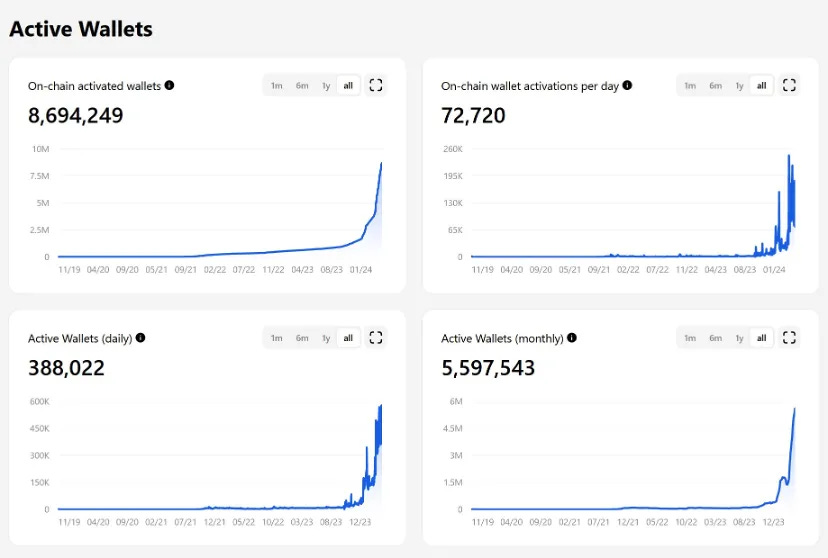
7. We've noticed that many Web3 game developers are promoting their applications on Google Play and even buying traffic, such as the promotion campaign for Big Time on YouTube, but the results have not been satisfactory. In light of this, do you think TON or Telegram could be a viable solution to break through the current situation?
There's actually no straightforward answer. It's crucial to discuss this issue because sometimes perspectives in the industry can be quite limited, failing to look outside the box. The reality is that even in the Web2 gaming sector, buying traffic is challenging, with costs skyrocketing across all genres.
The current gaming companies are too large, mature, and profitable. They've exhausted nearly every user category, making it difficult for other companies to acquire users. Even if you're not developing a game but just an application, acquiring users through Google Play is tough.
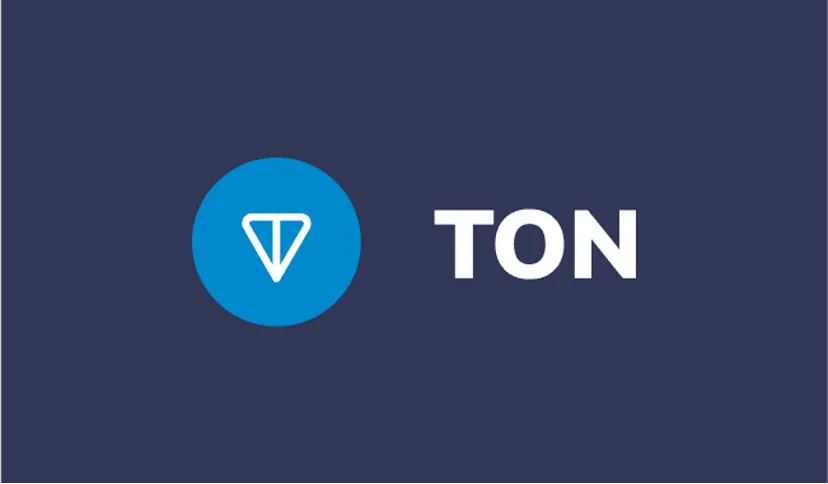
This is not a problem unique to Crypto games but an issue with the entire app ecosystem. So, with Telegram having 900 million monthly active users and never having monetized or engaged directly with actual users before, opening up to everyone now represents a significant traffic opportunity. This could be meaningful not just for Web3 but potentially for all internet applications in need of new users and traffic.
8. Could TON be a breakthrough point for Web3 games?
Yes, it certainly could be a breakthrough point, especially for the mini-game ecosystem.
We're all familiar with the state of WeChat mini-games. If you talk to some Chinese publishing companies in the industry, they often start by acknowledging the quality of a game but then inquire about the app version, the game's genre, the current cost of acquiring users for that genre, the LTV (lifetime value of users), and ARPU (average revenue per user). After hearing the numbers, they might advise against continuing if the costs are too high, as it would likely lead to losses, and publishing companies wouldn't take it on.
However, they often follow up with the suggestion of creating a mini-game version, which they could help promote. The situation with TON isn't much different. With 900 million monthly active users, while not as large as WeChat, it's still significant. TON has a substantial user base, and its ecosystem holds similar potential.
9. From the perspective of developers, we find that Web3 game developers can generally be divided into two categories: one is traditional Web2 game developers who focus more on gameplay but are relatively weak in tokenomics; the other is native Web3 game developers, such as those developing fully on-chain games, who may not be as familiar with game design but excel in on-chain asset management. Which type of developer do you favor, or which type do you think is more likely to drive the development of Web3 games?
I believe we need to look at the spectrum of the gaming industry, which has been polarizing in recent years. Mid-core games have almost disappeared:
On one end, you have AAA-quality heavy games, primarily on PC. This is a bit of a reversal, as more gamers are now willing to invest in good graphics cards and PCs for AAA-quality experiences, whether in shooters, open-world games, MMORPGs, or action games. These players are deeply invested in consuming high-quality content.
On the other end, there are the casual mini-games.
The mid-core games that once dominated the mobile platform have gradually faded.
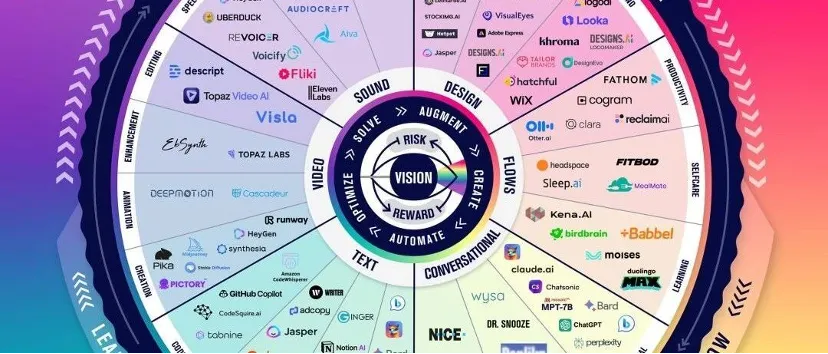
The reasons for this polarization are partly due to the segmentation of the player base. Some players casually play games to keep up with trends but eventually find themselves gravitating toward either hardcore, highly immersive experiences or very casual ones. Thus, the spectrum splits into two extremes.
Similarly, in Web3, you either have projects that can raise a lot of money with top-tier, luxurious teams pushing for AAA quality, aiming to compete with Web2 AAA games. Web3 has enough financial leverage to support such endeavors, provided many top-notch teams join in. If there are all-in, highly skilled teams willing to commit to developing high-quality, hardcore Web3 games, the financial resources are ample for development, unlike in traditional equity markets. So, there's leverage here.
On the other end, you have the mini-game sector focused on user acquisition. Some mid-sized developers and mid-core games struggling to survive may temporarily transition to Web3. However, in the long term, such developers may still lack competitiveness. The industry seems to dictate a clear direction, as indicated by Web2, where they can either temporarily enter the space but eventually face a choice: either pivot to mini-games or aim for high-quality titles by securing significant funding. The future will likely follow this trajectory.
10. In terms of the lifecycle of Web3 games, we've observed that, unlike Web2 games with relatively fixed lifecycles—such as card games typically lasting one to two years, SLG games up to four to five years, and MMO games possibly up to ten years—Web3 games, due to the openness of asset trading, have significantly accelerated lifecycles. Currently, many Web3 games have very short lifecycles, usually only one to two months, and at most half a year. What are your thoughts on this? Do you think measures should be taken to extend the lifecycle of Web3 games, or are these games inherently destined to be short-lived?
I believe we can draw some lessons from the history of the industry.
Ten years ago, in 2013 and 2014, mobile games also had lifecycles of only two or three months. However, Chinese gaming companies managed to extend these lifecycles through their operations, from two to three months to six months, one year, two years, and even three years.
Chinese teams are the most experienced when it comes to long-term game operations, unlike their Western counterparts who often focus on content-driven games and treat games like movies. They lack a deep understanding of "service games," a concept that Chinese game companies grasp more profoundly. This industry insight and the abundance of talent are unique to Chinese teams, who are dedicated to long-term operations.
The main reasons for the short lifecycle of Crypto games are:
1. The games aren't engaging enough: If the game isn't fun, how can players stay engaged over time?
2. Incorrect user composition: Most users come to buy assets rather than play the game long-term.
From my perspective, the focus should definitely be on the quality of the game itself. The game should be of high quality, comparable to good Web2 games, and the development team should have the necessary skills. The game must be enjoyable, and the team should have a solid understanding of Web3.
In the Web2 realm, it's nearly impossible for game products and companies to capitalize, as they cannot monetize the future value of the next ten years. However, with Crypto, it is now possible for the best game teams in China to have the leverage to take significant risks.
Who is willing to take this on? I think the vision is clear.
11. This brings up another issue: due to the shorter lifecycle of Web3 games, teams need to continuously invest in the long term. However, the funding model for Web3 is entirely different from Web2. In Web3, the funding is front-loaded; teams may quickly raise a large amount of capital once their tokens are issued and listed on exchanges, which may lead them to lack the motivation to continue pushing the project unless they possess exceptionally high moral standards. How do you think this issue should be addressed? Is it necessary to change the existing funding model or take other measures to ensure the team's continued commitment and the long-term development of the project?
Yes, I think this is a common problem for all Web3 projects. Recently, there was a tweet mentioning that the rapid capitalization in the Web3 world forces venture capitalists to seek out individuals with "crazy ideas," as only they believe their projects can fundamentally change the industry. The early stage of capitalization allows for quick financial gains, which is not a problem per se but rather an attractive feature of the industry—it means easy access to financial leverage.
Take your question, for example: if a company makes a game, lists on the stock market after two years, and then stops developing, isn't that essentially the same issue?
Some game companies are willing to continue developing, and not all of the leading companies listed on the A-share market stopped after listing. Many continue because they know they're on the right path, with genuine innovation that can be sustained long-term. Such companies can grow from a market value of tens of billions to hundreds of billions, continuously expanding.
The capital market provides leverage and resources, which are meant for the best people to use effectively. The potential impact is significant, but if developers are short-sighted and only seek short-term gains, they won't fit in, even if they make money.
But what are we looking for? Especially for VCs like us who want to change the industry's status quo because of our passion for it, we aim to find those who can make the best use of these resources.
Raising funds quickly through token listings is not an issue; it's good for ongoing development. If the project performs well in the capital market, it allows for long-term development and planning, freeing the team from focusing on short-term gains, which can actually be beneficial.
12. Web3 games are currently in a downturn. Besides the market conditions, what other factors do you think have contributed to this situation?
As I mentioned earlier, several key games haven't been released yet. Take Catizen, for example. From a revenue, daily active user, and user base perspective, it's already doing quite well. It could technically launch now, but they choose not to. Why? What are they doing lately?
1. Expanding the Team: They're hiring more people to develop additional mini-games.
2. Transitioning to a Platform or Publishing Company: They recognize that they can become a platform or at least a publishing company. They are building relationships, welcoming others to use their channels, and even advertising, effectively transforming into a publishing company and platform.
This is a great example of how the founder and core team view the situation: they could settle with their current success or aim for something bigger. They chose the latter, seeking further growth.
Regarding the current industry's challenges and downturn, it's partly due to the market cycle. A bull market turning into a bear market naturally leads to a loss of liquidity. Exchanges are also showing anxiety, not listing new projects as frequently as in the previous bull market. Due to various reasons like regulation and compliance, exchanges have deliberately slowed down their listing pace. So, with the market turning bearish and a lack of liquidity, it's expected.
Additionally, new and good projects haven't launched yet. This has led to a perception of stagnation. The lack of successful teams and projects makes it difficult for subsequent teams to secure funding, as there are no successful cases to reference. It's similar to how Chinese internet companies struggle to go public in the U.S. without a clear valuation benchmark, making it hard for early-stage VCs to invest. If the VC business model doesn't work, they won't invest.
Historically, in the crypto space, infrastructure (Infra) has always been valued higher and seen as more durable than applications (Application). This has been true since the bull market of 2017. However, not everyone can invest in infrastructure. We, for instance, don't invest in Infra.
From an application standpoint, China has the best teams and resources. We have easy access to them and extensive experience, so we know how to evaluate them. That's why we're willing to invest in applications, including crypto games.
We have continued to maintain our investment pace this year, making at least one investment per month, with varying sizes. We constantly observe and evaluate projects. If we were to stop investing during a bear market, why did we establish this fund in 2023 and decide to invest in 2023? We believe that there are some long-term industry logics that remain consistent.
13. Given the current stage of the Web3 game industry this year, what advice would you give to a Web3 game development team?
I would suggest two approaches. A little over a month ago, I noted that game companies emerging now should not be judged by the quality standards of projects already visible in the market. Many high-quality games are still under development and haven't been released, so they aren't visible to the public. The quality of Web3 games has become highly competitive. On one end of the spectrum, AAA-quality projects that have raised significant funding are already highly competitive, but they are still under the radar. They haven't launched large-scale marketing campaigns, and even many farming communities and guilds are unaware of them. We know this because we're involved in observing the development phase.
In development, we've already seen very high-quality and outstanding teams. Moreover, these teams are quite sizable. In other countries, a Web3 game studio with 20 or 30 people is considered large, but in China, we're talking about teams of 70 to 100 people—it's already very competitive.
For small teams looking for lower risk, focusing on mini-games might be a better approach. Avoid mid-core games, as spending a year developing a mid-core game could result in facing off against the highest quality games, which could lead to failure. Additionally, acquiring users and operating the game could be challenging without significant resources.
14. Lastly, what are your thoughts on the market outlook? Some people think this cycle has ended and are preparing for the next one, while others believe there might still be a rebound or even new highs.
In the past six months, we've seen two rate cuts, with at least one more expected in the second half of the year. Rate cuts suggest a normalization of rate cuts next year, meaning we could see a regular pattern of rate cuts, similar to 2022, with monthly cuts. If we start seeing rate cuts every month in 2025, liquidity will begin to move away from government bonds.
The initiation of rate cuts can cause temporary market unease, with some speculating that it might indicate a recession in the U.S. This belief in a recession narrative might lead some market participants to sell off their assets, resulting in a small dip. So, first, we might see 1-2 rate cuts in the second half of the year. Second, as the cycle of rate cuts begins, the market might experience a slight dip due to asset sell-offs by those fearing a recession. However, this dip would release market liquidity, increasing the absolute amount of money, which will eventually drive up all risk assets.
Currently, we saw a peak at $72,000 when the ETF was released, then it dropped to $66,000, $60,000, and now it's at $53,000. Essentially, after a drop, if the cycle of rate cuts begins and liquidity increases, especially given the current high-interest rate environment, a low-interest rate environment would certainly push the market higher. I'm personally expecting a new high of around $100,000, possibly by the end of this year. If not by the end of this year, then perhaps early next year, as the cycle of rate cuts will undoubtedly start in early 2024. The market will reach that level, and how much higher it goes is uncertain.
I believe we should maintain confidence in this industry, especially considering the migration of highly skilled Web2 game developers. This migration is a process. From my annual interactions with them, it's evident that the survival environment for Chinese Web2 game companies, particularly small and medium-sized ones, is extremely harsh. Those with a passion for gaming and a desire to create games will inevitably join the industry. They have the option of either working for a big company or pursuing their own game ideas. Crypto games offer a great refuge for them.
The question is how many people are determined enough to enter the industry earlier. If they join early, they can learn quickly, perhaps within a year. If they take their time, they will need to understand the space thoroughly first.
Follow us
Twitter: https://twitter.com/WuBlockchain
Telegram: https://t.me/wublockchainenglish
Comments
Post a Comment